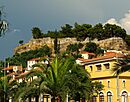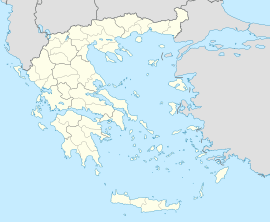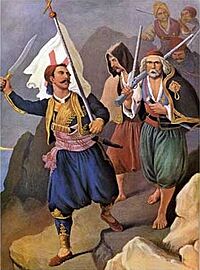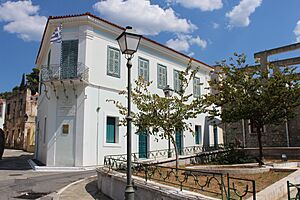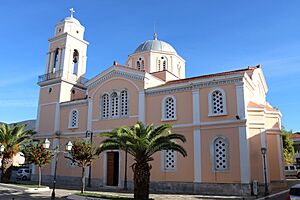Kalamata facts for kids
Quick facts for kids
Kalamata
Καλαμάτα
|
||
|---|---|---|
|
Clockwise from top right: Promenade of Kalamata, Saint John Church, Kyriakou Folklore Museum, Kalamata City Hall, Archaeological Museum of Messenia, Church of the Holy Apostles, Kalamata Castle
|
||
|
||
| Country | Greece | |
| Administrative region | Peloponnese | |
| Regional unit | Messenia | |
| Area | ||
| • Municipality | 440.3 km2 (170.0 sq mi) | |
| • Municipal unit | 253.3 km2 (97.8 sq mi) | |
| Highest elevation | 21 m (69 ft) | |
| Lowest elevation | 0 m (0 ft) | |
| Population
(2021)
|
||
| • Municipality | 72,906 | |
| • Municipality density | 165.583/km2 (428.86/sq mi) | |
| • Municipal unit | 66,135 | |
| • Municipal unit density | 261.09/km2 (676.23/sq mi) | |
| Community | ||
| • Population | 58,816 (2021) | |
| Time zone | UTC+2 (EET) | |
| • Summer (DST) | UTC+3 (EEST) | |
| Postal code |
241 00
|
|
| Area code(s) | 27210 | |
| Vehicle registration | KM | |
Kalamata (Greek: Καλαμάτα) is a large city in southern Greece. It is the second biggest city on the Peloponnese peninsula. Kalamata is the capital and main port of the Messenia region. It sits along the Nedon River at the top of the Messenian Gulf.
In 2021, about 72,906 people lived in the wider Kalamata area. Around 58,816 people lived in the city itself. Kalamata is famous for the Kalamatianos dance, delicious Kalamata olives, and rich Kalamata olive oil.
Contents
What's in a Name?
The name Kalamáta probably comes from a Greek phrase. It means "Virgin Mary with beautiful eyes." Another idea is that it comes from an older name, Kalámai. This word means "reeds."
How Kalamata is Governed
Kalamata is a municipality. It was formed in 2011 by joining four smaller areas. These areas are now called municipal units:
- Arfara
- Aris
- Kalamata
- Thouria
The whole municipality covers about 440 square kilometers (170 square miles). The main municipal unit of Kalamata is about 253 square kilometers (98 square miles).
Kalamata's Neighborhoods
The municipal unit of Kalamata is divided into several communities. Here are some of them, with their populations from 2021:
- Kalamata city proper (population: 58,816)
- Alagonia (population: 154)
- Antikalamos (population: 390)
- Artemisia (population: 88)
- Asprochoma (population: 1,244)
- Verga (population: 2,125)
- Elaiochori (population: 243)
- Karveli (population: 74)
- Ladas (population: 102)
- Laiika (population: 1,449)
- Mikri Mantineia (population: 615)
- Nedousa (population: 86)
- Piges (population: 71)
- Sperchogeia (population: 678)
A Look Back at Kalamata's History
Kalamata is built on the site of an ancient city. For a long time, people thought this ancient city was called Calamae. But in the 20th century, it was found to be Pharae. This city was even mentioned by the famous writer Homer. People used to think the area was under the sea back then. But old remains, like a temple, prove that people lived here a very long time ago.
Kalamata in the Middle Ages
Pharae was not very important in ancient times. It stayed quiet until the middle of the Byzantine era. Kalamata is first mentioned by its modern name in the 10th century. In medieval times, Kalamata was not a port city. Its coast did not offer good shelter for ships. The town was further inland, near Mount Taygetos.
As the main city of the rich Messenian plain, Kalamata grew a lot in the 11th and 12th centuries. Five churches from this time still stand, including the Church of the Holy Apostles. An Arab geographer from that time called it a "large and populous" town.
After the Fourth Crusade in 1205, Frankish lords took over Kalamata. Its old Byzantine fortress was too weak to defend. The town became part of the Principality of Achaea. It was an important center for the Villehardouin family, who ruled the Principality. Prince William II of Villehardouin was born and died here.
Later, in 1292 or 1293, local Slavic captains tricked their way into Kalamata castle. They took over the town for the Byzantine emperor. But the Franks soon got the town back. Kalamata remained under Frankish rule until 1428, when it became part of the Byzantine Despotate of the Morea.
Ottoman Rule and the Fight for Freedom
The Ottomans took control of Kalamata in 1481. In 1659, during a war between the Ottomans and the Venetians, the Venetians captured Kalamata. They wanted to distract the Ottomans. The Venetians took the town easily because the Ottomans left it. They plundered the town and destroyed its castle. Many men were taken to work on Venetian ships.
The Venetians returned in 1685 and again defeated the Ottomans near Kalamata. They destroyed the castle once more. Kalamata was then ruled by Venice for a while. During this time, the city grew and became richer. However, the Ottomans took Kalamata back in 1715. They controlled it until the Greek War of Independence.
Kalamata was the first city to be freed when the Greeks started their fight for independence. On March 23, 1821, Greek revolutionary forces took the city. Famous generals like Theodoros Kolokotronis and Petros Mavromichalis led them. But in 1825, an invading Ottoman officer, Ibrahim Pasha, destroyed the city.
Kalamata in Modern Times
After Greece became independent, Kalamata was rebuilt. It grew into one of the most important ports in the Mediterranean Sea. It even has the second-oldest Chamber of Commerce in the Mediterranean, after Marseille.
During World War II, a battle happened near the port on April 29, 1941. German forces fought against the 2nd New Zealand Division. Kalamata was freed on September 9, 1944.
On September 13, 1986, Kalamata was hit by an earthquake. It caused a lot of damage and sadly, 20 people lost their lives.
Today, Kalamata is a modern city that continues to grow. It is the second-largest city in Peloponnese in terms of population and business. It exports many local products, like raisins, olives, and olive oil. It is also the home of the Metropolitan Bishop of Messenia.
Places to See in Kalamata
Kalamata has many interesting historical and cultural places to visit:
- The Kalamata Castle from the 13th century.
- The Ypapanti Byzantine church.
- The Kalograion monastery, where famous Kalamata scarves are made from silk.
- The municipal railway park.
- The Church of the Holy Apostles, where the revolt against Ottoman rule was declared in 1821.
- Art collections can be found at the Municipal Gallery, the Archaeological Museum of Messenia, and the Folk Art Museum.
- The Kalamata International Dance Festival is a popular cultural event.
- The Kalamata Dance Megaron is a large dance center.
- The Port of Kalamata is the main port for the region.
- The Railway Museum of the Municipality of Kalamata shows old trains.
- Ancient Messene, an old city, is about 15-20 km (9-12 miles) northwest of modern Messini.
- The Temple of Apollo Epicurius is about a two-hour drive north.
- The Maria Callas Alumni Association of the Music School of Kalamata has an exhibition of personal letters from the famous singer Maria Callas.
The Cathedral of Ypapanti
Kalamata's main church is the Cathedral of the Ypapanti. It is located below the 14th-century Frankish castle. The church was started in 1860 and finished in 1873. It was badly damaged in the 1986 earthquake but was later repaired. The Festival of the Ypapanti is a very important event for the Greek Orthodox Church. On February 2nd, there is a special procession with a miraculous icon.
In 2010, the leader of the Ecumenical Patriarchate, Bartholomew, visited Kalamata. He celebrated the church's 150th anniversary.
Kalamata's Economy

Kalamata's Chamber of Commerce is the second oldest in the Mediterranean. The city is very well known for its black Kalamata olives. These olives are famous around the world.
The Karelia Tobacco Company has been making tobacco products in Kalamata since 1888.
Kalamata's Weather
Kalamata has a hot-summer Mediterranean climate. This means it has mild, wet winters and hot, dry summers. The city gets a lot of rain in winter. Summers are usually hot and sunny with little rain. The hottest temperature ever recorded in Kalamata was 45.0 °C (113.0 °F) on June 24, 2007. The coldest was -5 °C (23 °F) on February 14, 2004.
| Climate data for Kalamata airport, HNMS 1971–2010 normals | |||||||||||||
|---|---|---|---|---|---|---|---|---|---|---|---|---|---|
| Month | Jan | Feb | Mar | Apr | May | Jun | Jul | Aug | Sep | Oct | Nov | Dec | Year |
| Record high °C (°F) | 23.0 (73.4) |
26.0 (78.8) |
26.0 (78.8) |
30.9 (87.6) |
39.9 (103.8) |
45.0 (113.0) |
44.4 (111.9) |
43.2 (109.8) |
38.9 (102.0) |
37.0 (98.6) |
29.0 (84.2) |
26.0 (78.8) |
45.0 (113.0) |
| Mean daily maximum °C (°F) | 14.7 (58.5) |
14.9 (58.8) |
16.9 (62.4) |
19.9 (67.8) |
24.6 (76.3) |
29.1 (84.4) |
31.3 (88.3) |
31.4 (88.5) |
28.4 (83.1) |
24.3 (75.7) |
19.6 (67.3) |
16.0 (60.8) |
22.6 (72.7) |
| Daily mean °C (°F) | 9.8 (49.6) |
10.1 (50.2) |
12.0 (53.6) |
15.0 (59.0) |
19.7 (67.5) |
24.3 (75.7) |
26.5 (79.7) |
26.2 (79.2) |
22.8 (73.0) |
18.5 (65.3) |
14.1 (57.4) |
11.0 (51.8) |
17.5 (63.5) |
| Mean daily minimum °C (°F) | 5.4 (41.7) |
5.3 (41.5) |
6.4 (43.5) |
8.7 (47.7) |
12.4 (54.3) |
16.0 (60.8) |
18.8 (65.8) |
18.4 (65.1) |
16.0 (60.8) |
12.9 (55.2) |
9.4 (48.9) |
6.7 (44.1) |
11.4 (52.5) |
| Record low °C (°F) | −5.0 (23.0) |
−5.0 (23.0) |
−3.6 (25.5) |
0.0 (32.0) |
5.4 (41.7) |
9.0 (48.2) |
12.0 (53.6) |
12.4 (54.3) |
9.6 (49.3) |
4.2 (39.6) |
−0.4 (31.3) |
−3.4 (25.9) |
−5.0 (23.0) |
| Average precipitation mm (inches) | 105.6 (4.16) |
95.0 (3.74) |
66.3 (2.61) |
51.9 (2.04) |
22.8 (0.90) |
7.8 (0.31) |
6.0 (0.24) |
10.9 (0.43) |
36.7 (1.44) |
85.7 (3.37) |
141.7 (5.58) |
141.2 (5.56) |
780.3 (30.72) |
| Average precipitation days | 14.4 | 13.7 | 11.8 | 10.3 | 6.8 | 3.0 | 1.5 | 2.4 | 6.1 | 9.9 | 12.8 | 15.7 | 108.4 |
| Average relative humidity (%) | 75.0 | 73.5 | 73.3 | 70.3 | 66.3 | 57.7 | 57.8 | 61.3 | 66.8 | 72.1 | 77.6 | 77.3 | 70.1 |
| Mean monthly sunshine hours | 143.6 | 140.8 | 185.9 | 212.2 | 286.0 | 338.2 | 367.6 | 346.6 | 269.9 | 205.6 | 150.6 | 131.1 | 2,778.1 |
| Source: HNMS climate means, NOAA extremes & sunshine 1961-1990 Info Climat extremes 1991-present | |||||||||||||
Getting Around Kalamata
You can reach Kalamata by major roads like GR-7 and GR-82. There's also a motorway from Tripoli.
Kalamata used to have a train station. But in 2010, all train services from Kalamata stopped for economic reasons. The old train station building is now a Railway Park. You can see old steam engines there, and there's a café.
There are frequent bus services to cities like Tripoli, Corinth, and Athens. During summer, you can take ferries to Greek islands like Kythira and Crete. Also in summer, many flights come directly to Kalamata International Airport from European cities. Aegean Airlines also has a daily flight to Athens International Airport.
Kalamata also has four local bus lines that travel across the city and its nearby areas.
Delicious Kalamata Food

Kalamata is known for its tasty local foods:
- Kalamata olives: These are famous black olives.
- Lalagia: A type of fried dough.
- Diples: A sweet, crispy dessert.
- Pasteli: A sweet made from sesame seeds and honey.
- Talagani cheese: A special type of cheese.
- Sfela cheese: Another local cheese.
Famous People from Kalamata
Many notable people have come from Kalamata:
- Yiannis Chryssomallis (born 1954), a famous composer and musician.
- Prokopis Pavlopoulos (born 1950), a lawyer and professor who was the President of Greece from 2015 to 2020.
- Maria Polydouri (1902–1930), a well-known poet.
- Sokratis Papastathopoulos (born 1988), a professional footballer.
- Alexandros Koumoundouros, who served as Prime Minister of Greece in the 19th century.
- William II of Villehardouin (died 1278), a prince of Achaea.
- Michail Stasinopoulos (1903–2002), a lawyer and former President of the Republic of Greece.
Sports Teams in Kalamata
Kalamata has many sports clubs. Some of them have played in the top national leagues in Greek football. One of the oldest Greek clubs, Messiniakos FC, was founded here in 1888.
| Sport clubs based in Kalamata | |||
|---|---|---|---|
| Club | Founded | Sports | Achievements |
| Messiniakos GS | 1888 | Football, Volleyball | Played in Beta Ethniki football and A1 Ethniki volleyball |
| A.E.K. Kalamata | 1926 | Football | Played in Beta Ethniki |
| Apollon Kalamata | 1927 | Football | Played in Beta Ethniki |
| Prasina Poulia Kalamata | 1938 | Football | Played in Beta Ethniki |
| Kalamata FC | 1967 | Football | Played in A Ethniki |
| AO Kalamata 1980 | 1980 | Basketball, Volleyball | Plays in A2 Ethniki volleyball |
| Argis Kalamata | 1994 | Athletics | |
Kalamata's Sister Cities
Kalamata has special connections with other cities around the world. These are called twin towns or sister cities:
 Aglantzia, Cyprus.
Aglantzia, Cyprus. Xi'an, China
Xi'an, China Lowell, Massachusetts, United States
Lowell, Massachusetts, United States
Images for kids
See also
 In Spanish: Kalamata para niños
In Spanish: Kalamata para niños



